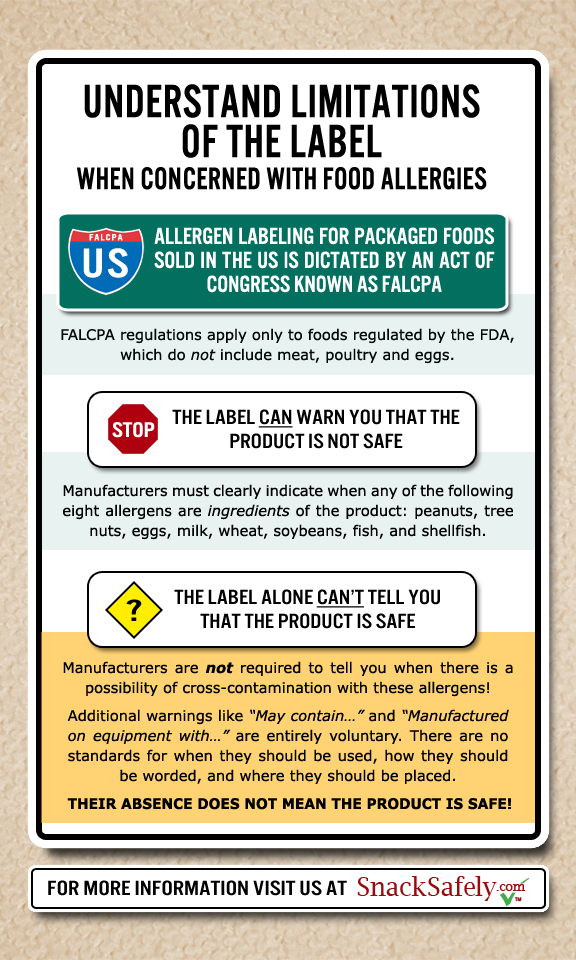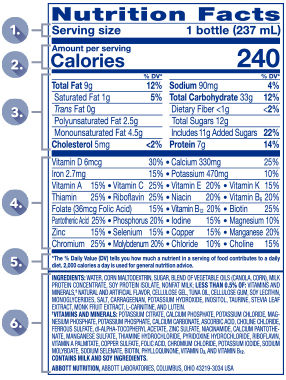40 understanding ingredients on food labels
Understanding Food Nutrition Labels - American Heart Association When the Nutrition Facts label says a food contains "0 g" of trans fat, but includes "partially hydrogenated oil" in the ingredient list, it means the food contains some trans fat, but less than 0.5 grams per serving. So, if you eat more than one serving, you could end up eating too much trans fat. How to Read Food Labels | mySugr The best place to begin is to look at the ingredients on the food label. Look for heart-healthy ingredients — oats, whole-wheat flour, or soy. Healthy fats like peanut, olive, and canola oils, seeds, and nuts are all good for heart health, too. It's best to avoid foods that contain excessive amounts of saturated fats, sugars, salt, and ...
Labels - Understanding ingredient labels - Center for Research on ... Cosmetic labels provide an overview of what the product does, the ingredients in the product, and any allergens (e.g., nut oils, etc.). Food labels will have the ingredient list under the " Nutrition Facts " heading to provide vital nutrient information for the product. It will also list allergen information.

Understanding ingredients on food labels
Ingredients & Food Science - Additives, Flavours, Starch Global Industry News. Lifestyle movement: Lonza Japan expands UC-II knee claims following positive trial findings from NutraIngredients-Asia.com; Experts offer first estimate of live microbes in food to move towards dietary recommendations from NutraIngredients-USA.com Understanding Food Labels Here's how to read food labels to better understand what you're eating and make healthy choices for yourself and your loved ones. Read the Ingredients List . Ingredient labels are on all foods that contain two or more ingredients. The most predominant ingredient is listed first, going in order of decreasing weight. Therefore, the ingredient ... Reading & Interpreting Ingredient Lists on Food Labels The ingredients are listed by weight; the ingredient that has the highest weight is listed first, and the ingredient with the lowest weight is listed last. This is important as we examine which...
Understanding ingredients on food labels. Understanding Food Labels and Ingredient Lists: FAQs and Do's and Don'ts Fresh eggs. Foods with insignificant amounts of the nutrients on the required label, such as coffee, tea, spices, flavor extracts, and food colors. These may contain ingredient labels but are unlikely to contain nutrition facts labels. Packaged single-ingredient meat products, such as deer, bison, rabbit, quail, wild turkey, and ostrich. Understanding Food Labels, Part II: The Ingredient Statement flavin, folic acid), eggs, sugar, butter (cream, salt), shortening (soybean oil, fully hydrogenated palm oil, partially hydrogenated palm and soybean oils, mono and diglycerides, TBHQ and citric acid [antioxi- dants]), leavening (sodium acid pyrophosphate, bak- ing soda, calcium monophosphate), vanilla (natural flavor), salt. Understanding Food Nutrition Labels - American Heart Association When the Nutrition Facts label says a food contains "0 g" of trans fat, but includes "partially hydrogenated oil" in the ingredient list, it means the food contains some trans fat, but less than 0.5 grams per serving. So, if you eat more than one serving, you could end up eating too much trans fat. Understanding Food Nutrition Labels | American Heart Association When the Nutrition Facts label says a food contains "0 g" of trans fat, but includes "partially hydrogenated oil" in the ingredient list, it means the food contains some trans fat, but less than 0.5 grams per serving. So, if you eat more than one serving, you could end up eating too much trans fat.
Understanding Ingredients on Food Labels - Professional Heart Daily ... There are many terms used for sugar on food labels. You might see sugar listed as the fourth ingredient in a product and think it's not so bad. But sugar can also be listed as high-fructose corn syrup or corn syrup, agave nectar, barley malt syrup or dehydrated cane juice, to name just a few. Read more about sugar and sweeteners. Understanding Ingredients In Food Labels | Eufic The quantity of a product's main or characterising ingredients must be declared, usually as a percentage, when the ingredient (or category of ingredient) appears in the name of the food, is normally associated with that food, or is given particular emphasis in the label (e.g. highlighted or pictured). Explaining ingredients Understanding Food Labels - Optum Care Learning how to read food labels can help you create a well-balanced diet. Here are some helpful tips: Eat a variety of healthy foods. Focus on foods like lean meats and fish, whole-grain products, low-fat dairy, vegetables and fruits. Look at the ingredients list. Ingredients are listed from most to least. If sugar is the first ingredient ... › food-safety › safe-food-handlingFood Product Dating | Food Safety and Inspection Service Oct 02, 2019 · The U.S. Department of Agriculture (USDA) does not require quality or food safety date labels for products under its purview. However, the USDA does require a "pack date" for poultry products and thermally processed, commercially sterile products to help identify product lots and facilitate trace-back activities in the event of an outbreak of ...
2.5 Understanding Food Labels - Introduction to Nutrition and Wellness The FDA uses the following definitions for interpreting the %DV on food labels:4 5%DV or less means the food is low in a nutrient. 10% to 19%DV means the food is a "good source" of a nutrient. 20%DV or greater means the food is high in a nutrient. Understanding Food Labels - Food Ingredient Facts Food labels are required to list all ingredients contained in the food in descending order based on the amount found in the final product. Most food additives are therefore found toward the end of the ingredient list. This indicates they are used in very small amounts in the food, generally less than two percent of the product. How to Read Food Labels Without Being Tricked - Healthline Understanding Food Labels food labels? No. The only foods that have to be declared are those the FDA considers major food allergens: milk, wheat, egg, peanuts, tree nuts, fish, crustacean shellfish, and soy, or ingredients that contain proteins from these foods. Do major food allergens contained in dyes (food coloring), spices, flavorings, additives and processing
How To Read Food and Beverage Labels | National Institute on Aging There are three types of product dates commonly printed on packaged foods and beverages: "Sell by" tells how long the manufacturer suggests that a store should sell items such as meat, poultry, eggs, or milk products. Make sure you buy by this date. "Use by" tells how long items will be at peak quality.
Understanding Food Labels - Nutrition: Science and Everyday Application The FDA uses the following definitions for interpreting the %DV on food labels:4 5%DV or less means the food is low in a nutrient. 10% to 19%DV means the food is a "good source" of a nutrient. 20%DV or greater means the food is high in a nutrient.
PDF Understanding Food Labels! Helping your kids understand how to read the Nutrition Facts label on food and beverage packages is important. After all, the label is a tool for making healthy food choices that they'll be able to use throughout their lives. Tips for Kids Be a Role Model for Label Reading Family Actions for Making Smart Food Choices Use teachable moments in ...
Understanding Ingredients on Food Labels - American Heart Association There are many terms used for sugar on food labels. You might see sugar listed as the fourth ingredient in a product and think it's not so bad. But sugar can also be listed as high-fructose corn syrup or corn syrup, agave nectar, barley malt syrup or dehydrated cane juice, to name just a few. Read more about sugar and sweeteners.
Understanding Food Labels - Home & Family Ingredient List. Packaged food products include a list of ingredients used in making the food. Ingredients are listed in order of weight with the most abundant ingredient appearing first, and the ingredient in the smallest amount being last on the list. Healthy eating tip: avoid buying foods that list sugar in the top 5 ingredients. Best Before ...
Understanding Food Labels | Food & Water Watch Country of Origin Labels. For now, the United States requires Country of Origin Labeling (COOL) on chicken, seafood, produce and some nuts that tells us basic information about what country our food was produced in - but the food industry has limited even this most basic element of transparency. Until late 2015, beef and pork were also ...
Understanding Food Nutrition Labels | EmPOWERED To Serve The U.S. Food and Drug Administration (FDA) regulates the Nutrition Facts label seen on packaged foods and drinks. In 2016, the FDA released changes to the label to make it easier to see how many calories and added sugars are in a product and to make serving sizes more realistic. These changes are still being implemented throughout the food ...
Food Labeling & Nutrition | FDA Food labeling is required for most prepared foods, such as breads, cereals, canned and frozen foods, snacks, desserts, drinks, etc. Nutrition labeling for raw produce (fruits and vegetables) and ...

/person-lifting-milk-jug-from-dairy-aisle-shelf-693673429-5b2a66658e1b6e003e684b0d.jpg)


Post a Comment for "40 understanding ingredients on food labels"